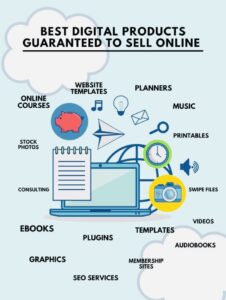How to Sell Digital Products: A Step-by-Step Guide for eBooks, Canva Templates & More
Learn how to sell digital products like eBooks, Canva templates, and more with this comprehensive guide. Discover platforms, strategies, and tips to start your online business today.
Want to Know How to Sell Digital Products Without Inventory or Shipping?
Did you know that over 60% of online entrepreneurs now earn income through digital products? Whether it’s an eBook, Canva template, design file, or course — selling digital downloads has never been easier (or more profitable).
In this post, we’ll walk you through everything you need to know about how to sell digital products effectively. From choosing what to sell, to setting up your store, marketing your products, and avoiding common mistakes, this guide gives you the roadmap to success.
Why Selling Digital Products Makes Sense Today
The beauty of digital products lies in their scalability. Unlike physical goods, they require no inventory, no shipping, and no warehousing. Once created, they can be sold infinitely — often at high profit margins.
- Low startup costs: No need for manufacturing or logistics.
- Passive income potential: Earn money while you sleep.
- Global reach: Sell to customers anywhere in the world instantly.

Step-by-Step Guide: How to Sell Digital Products Online

Step 1: Choose Your Digital Product
Popular options include:
- eBooks
- Canva templates
- Stock photos/graphics
- Pitch decks and resumes
- Online courses and tutorials
Ask yourself: What are people already asking you for? That’s a great starting point.
Step 2: Create High-Quality Content
Whether you’re writing an eBook or designing Canva templates, quality matters. Invest time in making sure your product looks professional and solves a real problem.
Tips:
- Use tools like Canva Pro, Adobe InDesign, or Google Docs for formatting.
- Include clear instructions and examples where needed.
- Proofread thoroughly before publishing.
Step 3: Choose a Platform to Sell Your Product
You’ve got options! Here are some top platforms to sell digital products:
| Platform | Best For | Pros |
|---|---|---|
| Teachable | Online Courses | User-friendly, built-in marketing tools |
| Etsy | Printables, Templates | Established audience, easy setup |
| Shopify + EDD | All types | Customizable, scalable |
| Kajabi | Courses, memberships | All-in-one solution |
Step 4: Set Up Payment and Delivery
Most platforms automatically handle payments and delivery. Make sure you test the process from the buyer’s perspective to ensure smooth transactions.
Tools to Use:
- Stripe
- PayPal
- SendOwl
- Podia
Step 5: Market Your Digital Product
Even the best product won’t sell without visibility. Use these strategies:
- Email marketing: Build a list and send value-driven content.
- Social media: Share behind-the-scenes content and testimonials.
- Blogging: Write posts that solve problems related to your product.
- Paid ads: Run targeted campaigns on Facebook, Instagram, or Google Ads.
Best Practices for Selling Digital Products
- Create bundles: Offer discounts for multiple purchases.
- Add upsells: Suggest complementary products during checkout.
- Offer free samples: Let users try before they buy.
- Update regularly: Keep your product fresh and relevant.
- Collect feedback: Improve based on user reviews.
Common Mistakes to Avoid When Selling Digital Products
Avoid these pitfalls to keep your business growing:
- Underpricing: Don’t undervalue your work — research what others charge.
- Ignoring SEO: Optimize your product descriptions and blog posts for search engines.
- No email list: Misses out on repeat sales and customer retention.
- Poor branding: Confuses buyers and reduces trust.
- Not testing: Always check download links, payment gateways, and landing pages.
Expert Insights: Real Success Stories
We spoke with Sarah, a graphic designer who sells Canva templates on Etsy and her own Shopify site. She shared her journey:
“I started by creating one simple resume template. Within six months, I was earning $2,000/month passively. Now I have over 50 templates and teach others how to do the same.”
Takeaway: Start small, focus on solving one problem well, and scale from there.
If you’re just getting started, check out our post on Top 20 Digital Product Ideas to Sell Online. And if you want to grow your brand, read our guide to building an email list from scratch.
According to Statista, the global digital commerce market is expected to grow by 14% annually through 2027. And Shopify highlights that sellers using digital downloads see higher conversion rates than traditional e-commerce stores.
Frequently Asked Questions About Selling Digital Products
Do I need a license to sell digital products?
No, but make sure your content is original and doesn’t infringe on copyrights. If you use images or fonts, ensure they’re licensed for commercial use.
What’s the best platform to sell digital products?
It depends on your needs. Etsy is great for printables, Teachable for courses, and Shopify for full control and scalability.
How much should I charge for my digital product?
Research competitors, consider your time and effort, and test different price points. You can always increase prices later as demand grows.
Can I sell digital products on Amazon?
Yes, especially eBooks via Kindle Direct Publishing (KDP). However, other digital files may not be allowed unless they fit specific categories.
How do I protect my digital product from theft?
Use watermarks, limit access after purchase, and include terms of use. Some platforms also offer anti-piracy features.
Start Selling Digital Products Today — Your Journey Begins Here
Now that you know how to sell digital products like eBooks, Canva templates, and more, it’s time to take action. The key is to start small, stay consistent, and continuously improve your offerings based on customer feedback.
If you found this guide helpful, leave a comment below or share it with someone who wants to start their own digital business. Got questions? Ask them in the comments — we reply to every one!
Ready to Launch Your First Digital Product?
Download our FREE checklist: 7 Steps to Launch Your First Digital Product